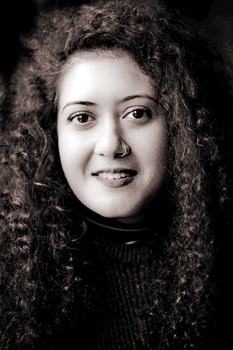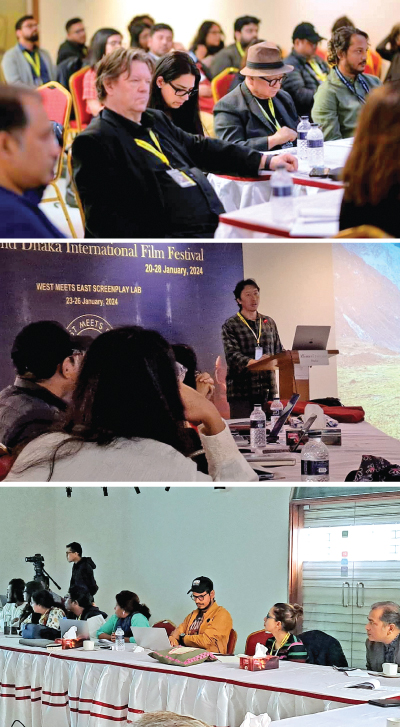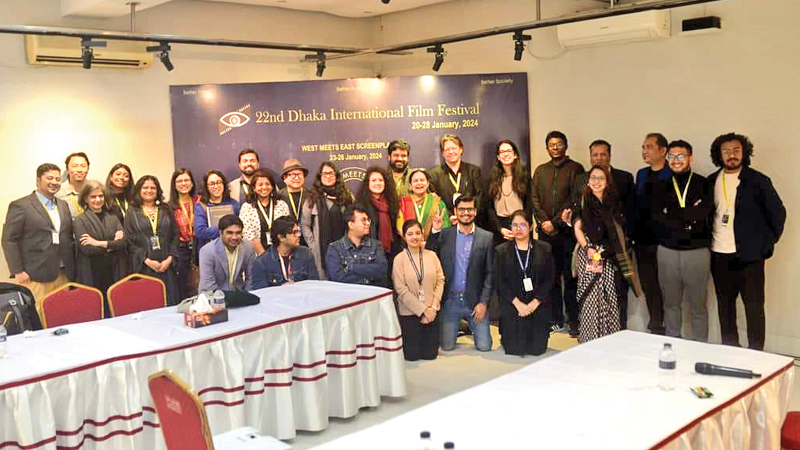 The West Meets East Screenplay (WME) Lab, an integral part of the Dhaka International Film Festival (DIFF), offers filmmakers from South Asia one of the greatest opportunities to secure funding and mentorship for script development.
The West Meets East Screenplay (WME) Lab, an integral part of the Dhaka International Film Festival (DIFF), offers filmmakers from South Asia one of the greatest opportunities to secure funding and mentorship for script development.
Since its inception in 2019, it has nurtured talent, with notable successes like Sri Lankan filmmaker Bhavaneedha Loganathan, who clinched the third prize in the latest edition.
As this great initiative gears up for the fourth edition in 2025, submissions are now open and Filmmakers from Sri Lanka, Bangladesh, Nepal, India, Afghanistan, Maldives, and Bhutan are invited to submit their full-length feature projects. This article is based on an insightful zoom discussion with Sadia Khalid, Co-convenor of the West Meets East Screenplay Lab, as we talk about the transformative potential of this remarkable initiative.
Q: Can you tell us how the West Meets East Screenplay Lab evolved since its inception in 2019 and the significant milestones it has achieved over the years?

Sadia Khalid
A: In 2019, we launched a day-long seminar during the Dhaka International Film Festival, aiming to provide a platform for guests from around the world to share their experiences with local participants and filmmakers. The positive response led us to expand this initiative. Recognising the growing interest, we transitioned to offering a screenplay lab as a valuable addition to the festival. This platform not only complements the existing DIFF but also caters to regional filmmakers, providing them with networking opportunities and support for their projects. Now in our third year, we’re excited to continue this journey and are currently accepting submissions for the fourth screenplay lab in January 2025.
Q: Could you provide insights into the filmmaker selection process for the lab, particularly regarding the criteria considered when choosing a project?
A: The selection process is overseen by a five-member jury board. They review all submissions and select the top 10 projects. These selected filmmakers are then invited to participate, and the same jury assesses their progress during the lab, ultimately choosing the top three projects. The organisers remain impartial, with no involvement in the selection process, which is handled by external professionals to ensure fairness.
In terms of criteria, the primary focus is on the merit of the script. We aim to break away from stereotypical narratives that are often associated with the region and instead prioritise storytelling quality especially in European film labs and festivals. Both local and international perspectives are considered, offering a broader evaluation framework.
The feasibility of production is crucial; we assess the commitment of the director, producer and writer to the project and its realistic prospects for realisation. Thus, while script quality is paramount, we also weigh factors such as the team’s capability and the project’s practicality in our selection process.
Q: Despite the East Screenplay Lab not typically focusing on contemporary themes, there seems to be a notable interest in animation projects, despite their typically high production costs. Do you prioritise animation scripts?

The West Meets East Screenplay Lab 2024 at the 22nd Dhaka International Film Festival
A: We didn’t anticipate receiving many animation submissions, considering Bangladesh has yet to produce any animation features, only shorts. However, when Sara Houssain submitted her project last year, it captivated everyone on the jury. Her project stood out not because we sought to highlight animation specifically, but because her story resonated deeply with all of us. Sara had meticulously prepared sketches and a compelling pitch, demonstrating her dedication to the project. Similarly, the Sri Lankan animation project garnered attention for its captivating storytelling and the commitment of its creators.
While we don’t necessarily prioritise animation scripts, these projects garnered support due to their quality and the dedication of their creators. Sara’s project, in particular, has secured funding and attracted producers since winning the lab, indicating its promising future.
While we’re unsure if we’ll receive many more animation submissions in the future, we’re hopeful that Sara’s success will pave the way for more animation projects in Bangladesh, possibly even the country’s first feature animation in the near future.
Q: When applying for a lab, understanding how to craft a compelling log line, synopsis, director’s intention, and treatment is crucial. Could you briefly explain these terms and their importance in pitching an idea effectively within a short timeframe for both shortlisting and winning a prize?
A: Absolutely, these elements are the backbone of any project application, as they shape the initial impression of the project before the director even enters the picture. Starting with the log line is key—it condenses the essence of your story into just a sentence or two, ensuring clarity and focus. If your idea can’t be succinctly expressed, it might lack cohesion. The synopsis then elaborates on the story, providing a broader overview, while the treatment maps out how the story unfolds on screen, scene by scene. This step is crucial because it requires envisioning the film’s execution before penning the script.
The director’s statement serves as a personal touch, explaining why the filmmaker is uniquely suited to bring this story to life and why it’s relevant now. These four components are what we assess when selecting projects. Once the top 10 are chosen, they have around two months to submit the first draft of the script. Mastering the art of crafting these elements can significantly impact a project’s chances of success in the lab and beyond.
Q: In our previous discussion, you highlighted the increasing number of applications, particularly from Sri Lanka, over the past four years. This year, Bhavanidha from Sri Lanka, who participated in the lab twice, won the third prize for her project. Based on the applications you’ve received, what areas do you think Sri Lankan filmmakers could improve upon in their proposal submissions?
A: Certainly, the number of applications has grown significantly over the years, with a noticeable increase from Sri Lanka. Many of these applicants show great promise, having participated in prestigious programs like Berlinale Talents and Asian film schools. However, when considering areas for improvement, practical aspects stand out.
For instance, Bhavanidha’s project faced scrutiny due to factors such as her limited animation experience and a completion timeline set for 2029, which raised concerns among the jury. Addressing such issues could potentially enhance the competitiveness of Sri Lankan submissions in the future. Despite these considerations, the quality of applications from Sri Lanka remains consistently high.
Q: The WME lab is primarily focused on the development stage of projects. Do you assess the progress of each winning project and support its completion?
A: We’re establishing an alumni association for our top 10 participants from each year. Consequently, we’re closely connected with everyone and monitor the progress of every film. While there’s no obligation for them to complete their projects, we do track their progress. Some films are already in production, while others have been completed and are making rounds in the festival circuit. We’re delighted that many of the producers we’ve connected with through the lab are actively involved in these projects. We’re exploring collaborations with other festivals to offer further opportunities, possibly through post-production labs. Currently, we’re maintaining communication with all participants, and the majority is making significant strides in their work.
Q: What were the main challenges you encountered in organising and managing the lab, particularly considering the difficulties in securing funds in Southeast Asia? How did you overcome these challenges?
A: Certainly, funding stands out as the primary challenge. However, our festival takes responsibility for this aspect, ensuring hospitality arrangements for participants and providing prize money. Nevertheless, I’m aware that the festival faces significant hurdles in securing funding each year, especially since we don’t charge any fees to participants. In contrast, European labs often charge substantial fees. Moreover, some labs require participants to arrange their own accommodations.But we don’t charge anything from the participants.
Another challenge is venue availability. Dhaka’s traffic congestion complicates matters, making it time-consuming to move between venues. We’re striving to alleviate this issue by consolidating our activities in one venue, which should streamline operations in the future.
There’s a perception among South Asians that European festivals are superior, which poses a psychological hurdle. Despite providing top-notch mentorship and resources, some individuals still believe that Western counterparts offer better opportunities. This mindset undermines confidence in our own mentors and experts. However, through continued collaboration and exposure to our local talent, we aim to shift this perception over time.
Q: Can you provide information about the submission process for next year’s lab, and share your future plans for the lab?
A: Certainly! Submissions for next year’s lab are open for the next three months, with the deadline set for the end of June. We require a logline (50 words), a synopsis (400 words), a director’s statement (400 words), a treatment (2000 words), and the director’s bio. Selected participants will have two to three months to complete their first drafts before submission.
Looking ahead, our plans for next year include securing a fixed venue to streamline operations and save time lost to traffic. We aim to pair up teams, providing not only mentorship but also peer review opportunities for healthy discussions during the lab. We’re also in discussions about expanding the benefits for winners, potentially offering opportunities for production development or post-production labs elsewhere.
To ensure fairness, we’re committed to ensuring that every jury member reads each submitted script. We’re maintaining a strict approach to this process this year. Notably, we’ve received compelling scripts and enthusiastic participants from Sri Lanka, indicating a promising future for their film industry despite its size. We hold high hopes for the Sri Lankan film industry and value any collaborations within the South Asian filmmaking community, which is the essence of our lab’s purpose.
For more info visit www.dhakafilmfestival.org/west-meets-east-screenplay-lab







